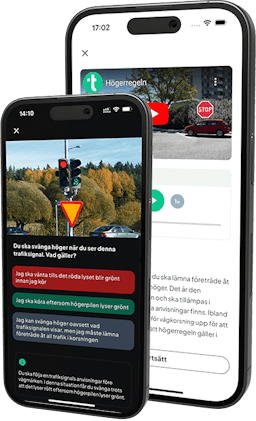Supplementary plates provide additional information to road signs. They are smaller signs placed beneath a road sign. A supplementary plate might indicate distance, the length of a road section or a time, for example. In this guide, we will take a look at some of the most common supplementary plates.
The supplementary plate (A) indicates the length of the road section that the associated road sign concerns. This combination (B) means that roadworks begin in 200 metres and end in 800 metres. The distance may also be expressed in kilometres (C).

If the supplementary place looks like this (A), then it indicates the distance to whatever it is the road sign concerns. In this situation, it would mean that roadworks begin in 100 metres.
Supplementary plates with time intervals (B) indicate what time of the day a road sign concerns. This combination (C) would mean that parking is not allowed between 08:00 and 17:00 on weekdays, between 08:00 and 14:00 on Saturdays or the days before a public holiday and between 08:00 and 13:00 on Sundays or public holidays.

Disabled (A). This supplementary plate will only ever appear in conjunction with the parking sign (B). This combination means that only disabled road users with a special permit are allowed to park here.

Symbol plate (A). This plate indicates which vehicles or traffic groups a road sign concerns. In this situation (B), only motorcycles and class I mopeds are permitted to use the parking space.

Impaired vision (A). This road sign indicates that persons with impaired vision may be present in the area.
Impaired hearing (B). This road sign indicates that persons with impaired hearing may be present in the area.

There are also supplementary panels which use arrows to indicate the direction in which a road sign applies.
Both sides of the road sign (A).
To the left of the road sign (B). In this combination (C), parking is permitted to the left of the road sign.

To the right of the road sign (A).
Before and after the road sign (B). In this combination (C), parking is prohibited before and after the road sign.

Before the road sign (A); i.e. up until the road sign. In this combination (B), it is prohibited to park before the road sign.

This supplementary panel (A) indicates the direction to whatever it is that the road sign concerns. In this situation, the road sign and the supplementary plate (B) tell us that there are roadworks on the intersecting road to the right.

All roads give way (A). This supplementary plate only ever appears together with the give way sign (B) and means that all vehicles at the junction have a duty to give way. Vehicles arriving at the same time must pay mutual consideration to one another.

All roads stop (A). This supplementary plate only ever appears together with the stop sign (B) and means that all vehicles at the junction have a duty to stop. Whichever vehicle arrives first at the junction is also the vehicle that should go first.

Junction, priority is indicated by the broader line (A). This supplementary panel indicates that both you and the vehicle on the road to the left have a duty to give way. The thin lines indicate which vehicles have a duty to give way. This supplementary plate can appear together with the give way sign (B) or the stop sign (C).

If there is no specific supplementary plate for a certain case then information may be given in text (A). This combination (B) means that the no motor vehicles sign applies only to through traffic. If your destination is an address located on this road then you may pass this combination of signs.

Multiple supplementary plates may be used together in certain situations. This is common in relation to parking. This road sign combination indicates that you can park for a maximum of two hours at a time. You must pay a parking fee between 08:00 and 17:00 on weekdays.



